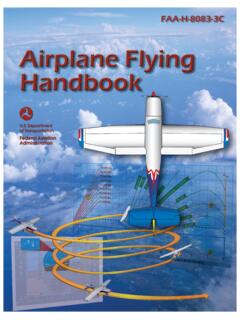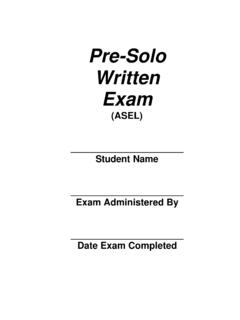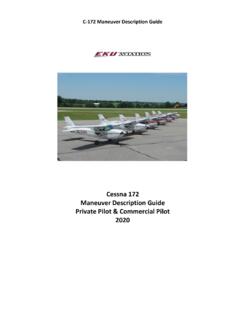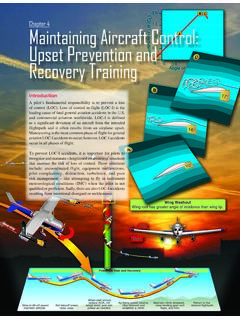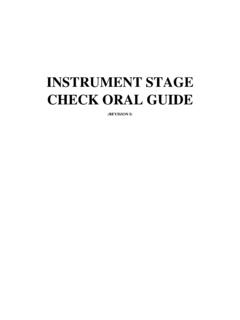Transcription of Flying Light Twins Safely - FAASafety.gov
1 Flying Light Twins Safely IntroductionThe major difference between Flying a Light twin and a single-engine airplane is knowing how to manage the flight if one engine loses power. Safe flight with one engine inoperative (OEI) requires an understanding of the basic aerodynamics involved as well as proficiency in single-engine flight. This booklet deals extensively with the numerous aspects of OEI flight. You must remember, however, not to place undue emphasis on mastery of OEI flight as the sole key to Flying Light Twins Normal TakeoffFor normal takeoff planning, use the manufacturer s recommended rotation speed (Vr) or lift-off speed (Vlof). If no such speeds are published, use a minimum of minimum control speed (Vmc) plus 5 knots for Vr.
2 As a rule, Light Twins should not be airborne before reaching lift-off, the next consideration is to gain altitude as rapidly as practicable. After leaving the ground, altitude gain is more important than achieving an en route climb airspeed. Allow the airplane to accelerate in a shallow climb to attain Vy, the best rate of climb speed when both engines are operating. Maintain Vy until a safe single-engine maneuvering altitude, typically at least 400 feet above ground level (AGL), has been achieved. (If Vy would result in a pitch attitude of more than 15 degrees, consider limiting the initial pitch attitude to 15 degrees to minimize control difficulty if an engine is lost.) A transition to an en route climb can then be made as climb power is gear retraction should occur after a positive rate of climb is established, but not before reaching a point from which a safe landing can no longer be made on the runway or overrun Critical EngineThe critical engine is the engine whose failure would most adversely affect the airplane s performance or han-dling qualities.
3 On twin-engine airplanes with both engines turning in a conventional, clockwise rotation (viewed from the cockpit), the left engine is critical. At cruise airspeed, the thrust line of each engine may be considered to be the propeller : The graphics and some of the material in this document have been modified from the original printed low airspeeds and high angles of attack, the effective thrust centerline shifts to the right on each engine because the descending propeller blades produce more thrust than the ascending blades (P-factor). The more power, the greater the effect. The right shifting thrust of the right engine operates at a greater moment arm (that is, distance from the airplane s center of gravity) than the left engine.
4 Thus, the right engine produces the greatest yawing moment and requires the most rudder to counteract the adverse Light Twins Safely Some Twins of more recent design use a counter-rotating right engine to eliminate the critical engine. Handling qualities are the same, regardless of which engine fails on one of these AsymmetryLoss of power on one engine creates both control and performance problems. Control problems include the need to counteract the following: Yaw. Loss of power on one engine creates yaw due to asymmetrical thrust. Roll. Loss of power on one engine eliminates propeller blast over the wing. This elimination affects the lift distribution over the wing, causing a roll toward the inoperative yaw and roll forces must be counteracted by a combination of rudder and SideslipSideslip is the angle at which the relative wind meets the longitudinal axis of the airplane.
5 In all-engine flight with symmetrical power, zero sideslip occurs with the ball of the slip-skid indicator centered. Pilots know this concept as coordinated flight. In OEI flight, however, zero sideslip occurs with the ball slightly out of center, deflected toward the operating Light Twins Safely In OEI flight, no instrument directly tells the pilot that the airplane is being flown at zero sideslip. The aircraft must be placed in a predetermined attitude of bank and ball deflection. In the absence of a yaw string, the suggested zero sideslip configuration at best single-engine rate of climb airspeed (Vyse) for most Light Twins is approximately two to three degrees of bank toward the operating engine, with the ball displaced about one-half of its diameter from center, also toward the operating flight with the ball centered and the remaining engine providing any appreciable power is never correct due to the sideslip generated.
6 Aircraft Flight Manual/Pilot s Operating Handbook (AFM/POH) performance figures for OEI flight were determined at zero sideslip, although that fact may not be expressly stated in the manual or Airspeeds for Single-Engine OperationsMinimum Control SpeedVmc is designated by a red radial line near the low speed end on most airspeed indicators. Under the small airplane certification regulations currently in effect, the flight test pilot must be able to accomplish the following: Stop the turn that results when the critical engine is suddenly made inoperative within 20 degrees of the original heading, using maximum rudder deflection and a maximum of 5 degrees angle of bank into the operative engine. Thereafter, maintain straight flight with no more than a 5-degree angle of the current 14 CFR Part 23 small airplane certification rules, Vmc is determined with the following factors: Maximum available takeoff power.
7 Propeller windmilling in takeoff pitch (or feathered, if the aircraft is equipped with autofeather). Most unfavorable (aft-most) center of gravity and maximum takeoff weight (or any lesser weight necessary to show Vmc). Landing gear retracted. Wing and cowl flaps in the takeoff position. Trimmed for takeoff. Airborne, out-of-ground results are then plotted for a variety of altitudes and extrapolated to a single, sea-level value. The twin that you are Flying may or may not have been certificated under exactly these rules the AFM/POH will state the certification varies with each of the above factors. The Vmc noted in practice or demonstration, or in actual OEI opera-tion, could be less or even greater than the published value.
8 With other factors constant, Vmc is highly sensitive to bank angle. It is reduced significantly with increases in bank angle, and it increases significantly as the wings approach level. Tests have shown that Vmc may increase more than 3 knots for each degree of bank less than 5 degrees. Loss of directional control may be experienced at speeds almost 20 knots above published Vmc when the wings are held Light Twins Safely Best Single-Engine Angle of Climb Airspeed Best single-engine angle of climb airspeed (Vxse) is used only to clear obstructions during OEI initial climbout because it gives the greatest altitude gain per unit of horizontal travel. Vxse is invariably a slower speed than Vyse and may be just a very few knots above Vmc.
9 Even at Vxse, the climb gradient will be Single-Engine Rate of Climb AirspeedBest single-engine rate of climb airspeed (Vyse) is designated by a blue radial line on most airspeed indicators. It delivers the greatest gain in altitude per unit of time, with the airplane in the following configuration: Inoperative engine propeller in the minimum drag position (feathered). Maximum power on the remaining (operative) engine. Landing gear retracted. Wing flaps in the most favorable (best lift/drag ratio) position. Cowl flaps as required for engine cooling. Airplane flown at zero from a windmilling propeller, extended landing gear, flaps extended beyond optimum, or any sideslip will reduce or even eliminate any modest single-engine performance that may exist.
10 Turbulence and maneuvering of the airplane will further erode performance. When operating above the airplane's single-engine ceiling, Vyse will deliver the least possible rate of sink (driftdown).Safe, Intentional OEI SpeedSafe single-engine speed (Vsse) is the minimum speed at which intentional engine failures are to be performed. This speed is selected by the manufacturer to reduce the accident potential from loss of control due to simulated engine failures at inordinately slow airspeeds. No intentional engine failure in flight should ever be performed below test pilots determination of Vmc in airplane certification is solely concerned with the minimum speed for directional control under one very specific set of circumstances.










